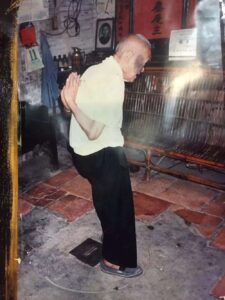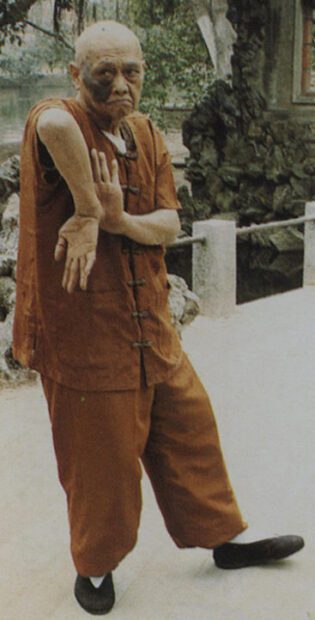Pan Nam: The Legendary Wing Chun Grandmaster
By Maurice Novoa a master under the Yuen Kay Shan, Ip Man and Pan Nam lineages.
Introduction
Pan Nam, also known as Peng Nan (彭南), was an exceptional Chinese martial artist and the esteemed Grandmaster of the Wing Chun style. Recognized for his remarkable skills, he made significant contributions to the world of martial arts. In this article, we will delve into the life, achievements, and philosophy of Pan Nam, shedding light on his remarkable journey and enduring legacy.
Early Years and Training
Born on December 24, 1911, in Foshan, Guangdong, Pan Nam began his martial arts journey at the age of 13. Despite his relatively short stature, his piercing gaze revealed the intensity and determination within him. During his early years, he studied various martial arts disciplines such as Shaolin Boxing, Hong Boxing, Bie Da, and Wing Chun. It is worth mentioning that he also explored the legendary Kuaishou Wing Chun.
At the age of 36 in 1947, Pan Nam had the opportunity to learn Wing Chun from Master Zhaoju, a direct disciple of Chen Rumian, who himself was a student of Chen Huashun. Zhaoju was an adept practitioner of Wing Chun, and under his guidance, Pan Nam further honed his skills in this particular style. Unfortunately, Master Zhaoju passed away in 1972.
Pan Nam’s ancestry can be traced back to Hua County, Guangdong, with his family later settling in Foshan during the Qing dynasty. Notably, Pan Nam possessed a distinct facial feature—a mole on his right cheek, referred to as Heimiannan. While his name may not have been widely recognized among martial arts seniors in Guangzhou, Foshan, Zhongshan, Nanhai, and Sanshui, his dedication to the art was highly regarded by his peers.
Throughout his life, Pan Nam tirelessly practiced martial arts, displaying an unwavering commitment to Wing Chun. His training hall was adorned with wooden stakes and an assortment of weaponry, including knives, guns, swords, and sticks. These “partners” became an integral part of his lifelong practice, earning him admiration and respect within the martial arts community.
During his formative years, Pan Nam explored a range of martial arts disciplines before focusing on Wing Chun. Despite initially being considered an outsider, he fearlessly embraced the art and learned from fellow Wing Chun masters of his generation.
Career and Contribution
Following the establishment of the People’s Republic of China, Pan Nam participated in the Guangdong Province Wushu Observation Competition in 1957. It was during this event that he had the privilege of meeting Master Li Yechi (1898-1970), who held a significant position within Pan Nam’s martial arts lineage. Master Li Yechi, as per seniority, was considered Pan Nam’s fellow master-uncle. In their encounters, Pan Nam sought guidance and advice from Master Li Yechi, only to be effortlessly subdued each time. In a remarkable display of humility, Pan Nam absorbed Master Li Yechi’s teachings, which focused on the “come, stay, go, and send” principles—techniques that emphasized using inner power to defeat opponents. Grateful for the knowledge imparted to him, Pan Nam continued seeking Master Li Yechi’s counsel, dedicating himself to passing down these invaluable teachings.
In his later years, Master Peng Nan devoted himself to organizing and preserving the knowledge of Wing Chun. He diligently sorted through Wing Chun’s intricacies, such as small thoughts, bridge search, indexing, and the eight-cut knives technique, with the intention of publishing them in a comprehensive book. One of the secrets he emphasized to his disciples was the importance of shedding prejudices in martial arts training, as they hinder progress and growth.
Passionate about promoting Wing Chun, Pan Nam actively participated in the Foshan Jingwu Association and played a pivotal role in establishing the Foshan Wing Chun Research Association. In his quest to preserve and advance Wing Chun, he conducted extensive excavation and compilation work, organizing Foshan’s Wing Chun heritage into a book. By doing so, he aimed to ensure the continued spread and development of Wing Chun for future generations.
Throughout his life, Pan Nam studied under several masters, including Master Gan Zhu (1931), Master Ma Fen (1942, Xinan Shaolin Boxing), Master Chen Tian (1943, furthering Shaolin Boxing), Master Li Zibin (studying southern lion dance, bone setting, trauma, miscellaneous diseases, and martial arts), and Master Liang Xisu (learning Southern Shaolin and equipment). His unwavering dedication to learning and researching martial arts remained steadfast, with a primary focus on Wing Chun. Given historical circumstances, Wing Chun had a significant presence in Foshan. Known for its practical combat techniques and straightforward movements, Wing Chun’s rich legacy resonated with Pan Nam’s philosophy. The Quan Jue concept of “indeterminate force and roots” encapsulated its essence, emphasizing elements such as staying centered, concealed strikes, adaptability, and the integration of internal and external strength. As a result, Wing Chun stands as a versatile boxing style that emphasizes technique rather than fixed forms.
In 1986, Pan Nam initiated the Foshan Jingwu Sports Association, which aimed to unify the various schools of Wing Chun. The Foshan Pengnan Wing Chun style integrated elements of the Hong Quan style, earning it the name “Wing Chun Hand, Hong Quan Jin.” This amalgamation represents the fusion of different Foshan fist techniques within the Ryazan lineage (associated with Ip Man).
Pan Nam also passed on his Wing Chun lineage to practitioners overseas, particularly in the United States and Australia, through his disciple Felix Leong. This dissemination of knowledge ensured that Pan Nam’s style would continue to flourish beyond his lifetime.
Pan Nam Wing Chun Tournament
The inaugural Pan Nam Wing Chun Boxing Tournament took place in 2018, organized by the Gaoming District’s Wushu Lion Sports Association at Hecheng Square. Over 200 participants from various branches under the Pan Nam zong branch competed in 55 events throughout the day.
The tournament commenced with a captivating lion dance performance, setting the stage for the day’s competitions. Group events featuring 14 participants took turns showcasing their punching skills, while children performed their martial arts routines on stage. The tournament also included duel exercises and consisted of different categories, such as children’s group, adults’ group, and juvenile group.
Pan Nam Wing Chun Boxing stands as one of the most prominent styles within the Wing Chun discipline. The primary objective of organizing the “2018 First Pan Nam Wing Chun Competition” was to bring disciples from around the world together, allowing them to experience the growth and development of Pan Nam Wing Chun while assessing the progression of practitioners across different generations. The technical insights gained from this event provide valuable parameters and experiences for future competitions. Moreover, this gathering serves to foster unity within the Wing Chun community, ensuring the preservation and advancement of Pan Nam’s invaluable skills.
Pan Nam’s Fighting Style and Techniques
Pan Nam’s Wing Chun style encompasses a diverse array of techniques that exemplify his martial prowess. Notable techniques include:
– Plowing and blocking the stall, sticking and swaying
– Pushing, pulling, pressing, and tangling to create advantageous positions
– Bending hands to maintain a central position while simultaneously attacking and defending
– Straight-hand strikes and various applications of pressure to control opponents
– Adapting to an opponent’s movement, exploiting empty spaces in their center of gravity while maintaining sticky hands
– Utilizing varying degrees of flash and pitch, both large and small, to outmaneuver opponents
– Emphasizing situational awareness, critical for accumulating momentum and seizing opportunities
– Utilizing the second bridge to gain an advantage while engaging in inner curtain techniques
– Understanding movement patterns and skillfully navigating between offense and defense
– Employing one punch and one palm techniques, focusing on three specific stopping points—shoulder, elbow crutch, and base of the palm—to deliver powerful strikes
– Practicing light and steady footwork, with an unwavering bridge and stable hip and waist movement
Pan Nam’s style also incorporates a variety of footwork techniques, including hooking, stitching, flicking, and kicking, as well as inching, crutching, teasing, killing, and stepping on techniques.
Additionally, Pan Nam’s style features the Five Petal Plum Flower set—an iconic five-part exercise regimen designed to strengthen tendons. Furthermore, the style includes Chi Sao Sticky Hands and a partner practice known as Waist Pressing, akin to Push Hands exercises, where opponents strive to off-balance each other.
The tactical insights and techniques revealed in Pan Nam’s teachings provide an invaluable foundation for learning Wing Chun. Moreover, they offer a rich theoretical framework for studying and researching Wing Chun, while simultaneously facilitating its continued spread and development in the future.
Later Years and Legacy

Even after his retirement, Pan Nam remained devoted to his practice, imparting his martial arts wisdom to disciples during his senior years. He often shared anecdotes about the origins of Wing Chun, further inspiring his students.
On October 28, 1995, Pan Nam passed away in Foshan, leaving behind a lasting legacy. In his final moments, he expressed his sincere desire for his disciples to carry forth his legacy, wholeheartedly dedicating themselves to the practice of martial arts. He hoped that the precious cultural heritage of Wing Chun would be meticulously organized and published in a comprehensive book.
Pan Nam’s impact on Wing Chun remains immeasurable, as his teachings and contributions continue to influence practitioners worldwide. His dedication, relentless pursuit of knowledge, and profound understanding of the art have solidified his status as a legendary Grandmaster, forever etched in the annals of Wing Chun history.

